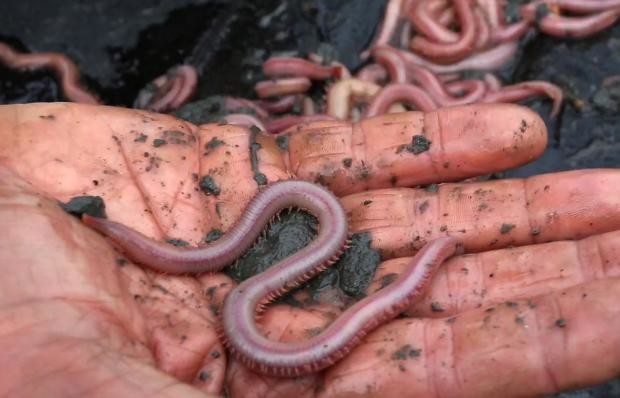
In this photo, taken March 21, 2017, a bloodworm is seen in Harpswell, Maine. Fishermen who harvest marine worms are struggling to meet the worldwide demand for the prized bait. The worms are shipped around the globe to bait the hooks of sport fishermen. (Photo by ROBERT F. BUKATY / AP)
WOOLWICH, Maine — Dan Harrington makes his living unearthing marine worms by hacking away at mudflats with a tool that resembles the business end of an old steel rake.
He’s fine with the freezing weather, the pungent aromas and the occasional nip from an angry crab, but his latest problem is the big one — the worms just aren’t there like they used to be.
“A bad day is zero worms,” said Harrington, a second-generation worm raker. “A bad day is when you try out five, six different spots and don’t even make enough money to replenish the gas that you put in your tank.”
Harrington’s struggle, and that of his fellow wormers, has reverberations around the world. A mysterious drop in the harvest of two of the most popular worms for sport fishermen is proving expensive for anglers, perilous for bait shop owners and a threat to a way of life in Maine.
Maine harvesters are by far the US’s largest suppliers of sandworms and bloodworms, twisty, fat critters that can grow longer than a foot and have teeth that inflict a painful bite. Wormers dig the wriggling creatures out of coastal muck so they can be sold to fishermen worldwide.
The worms are especially popular with American striped bass fishermen and in Europe. An October study in the journal Fish and Fisheries said bloodworms are the most valuable marine worm species on the retail bait market, and sandworms aren’t far behind.
The worms, which burrow into the mud and eat things like algae and microorganisms, are coveted as bait because they are natural food to some fish.
But the worm falloff has disrupted the supply chain. Maine’s catch of bloodworms has dropped from more than 600,000 pounds in 2004 to less than half that last year. Sandworms dipped by two thirds, to less than 130,000 pounds.
Scientists are struggling to figure out where the worms have gone. Among the factors that could play a role in the decline are rising temperatures in the Gulf of Maine, changes in currents that distribute worm larvae and increased harvesting pressure, said William Ambrose, a Bates College professor and marine researcher.
It’s also possible a growing number of invasive green crabs is preying on the worms, said Brian Beal, a marine ecology professor at the University of Maine at Machias. But Beal and Ambrose say more research is needed to understand what’s going on.
Efforts by the government to intervene have been met with resistance. A committee of the Maine Legislature this year considered a bill that would’ve shut down worm digging for four months a year to help preserve the industry, but it didn’t pass.
The proposal generated skepticism from as far away as the suburbs of Sacramento, California, where Big Red Worm Co. sells worms airmailed from Maine in boxes alongside seaweed and cooling packs.
Shortening the season would be untenable, said operations manager Glenn Chadaris.
“That would pretty much kill every bait shop,” Chadaris said.
Fishermen, too, have been feeling the sting. The price for bloodworms at the dock has more than doubled since 2001, to nearly $16 per pound, and that cost is eventually borne by consumers. Sandworms are less expensive but have similarly jumped in value.
Patrick Paquette, a past president of the Massachusetts Striped Bass Association, said the retail price for a dozen marine worms has about doubled from five years ago. They typically sell for about $7 to $12 for a dozen.
As a wild food source for bottom-dwelling fish, worms are especially effective for catching winter flounder in Boston Harbor’s popular recreational fishery, Paquette said. But, he added, “It’s extremely more expensive.”
Maine considers marine worms a fishery, and it’s one of the most valuable in a state known for crowd pleasers like lobsters and clams. The worm harvest was worth about $5.6 million last year.
Worming, which requires a $50 license, has long been an employment source in rural areas without much industry. Some fulltime diggers can make more than $50,000 in a good year, Harrington said. Others dig worms when they aren’t raking clams, trapping lobsters or fishing for eels.
Some suspect the lower harvest might mean fewer people are worming, but state data show the number of diggers has held steady, with 880 in 2007 and 857 last year.
It’s also possible the remaining diggers are doing the back-breaking work less often as they age or have a harder time finding worms.
Harrington, who’s been raking for 38 of his 46 years, describes his back as “a train wreck” but says he plans to stick with it.
“The idea of walking in through a gate and having it close behind me doesn’t appeal to me,” he said. “I like to be out in nature, out in the mud.”/rga

